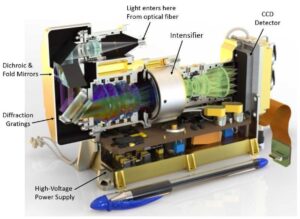The NASA Perseverance Mars rover is using a device produced by Elbit Systems of America to intensify images similar to night vision technology and the company is working to further advance the technology, an executive said.
At the top of the rover’s mast is the SuperCam developed by Los Alamos National Laboratory in New Mexico. It has five remote techniques meant to study the geology of Mars and help collect samples. SuperCam instruments include an infrared laser beam to remove dust and material from surfaces that creates a flash whose optical spectrum reveals the chemistry of targets as well as a green laser beam to determine the molecular composition of surface materials.

“Inside the SuperCam and specifically the spectrometer portion of the SuperCam is an image intensifier and the product that we sold to the Los Alamos National Laboratories,” Erik Fox, vice president and general manager of Elbit Systems of America – Night Vision, told Defense Daily in a recent interview.
This image intensifier is a vacuum tube called the Image Intensifier Tube.
“So what it does is it takes photons in, it converts them to electrons, amplifies those electrons, and then have photons coming out. So another terminology is low light amplifier, so that’s why in military applications it helps to see at night: it takes the ambient light that’s out there in the atmosphere from starlight, moonlight and then amplifies that to allow the soldier [or] first responder to have better night vision capabilities,” Fox said.
In the Mars context, the intensifier is used to amplify the reflected light of the laser coming back to the SuperCam.
“So its coming in the unit and then its taking that laser light, essentially and amplifying that so that it’s a better signal coming out the other end. And then it can be analyzed to determine the makeup and composition of the formation, whether its minerals or rock sample formation,” Fox said.
He confirmed the company sold hardware rather than software and worked with Los Alamos on the implementation and application of the Image Intensifier Tube. When Elbit America sells this technology to the military it also includes software to go around it and work within the system, but here Los Alamos created the spectrometer unit that goes around the intensifier.
“They really did the full work there, we provided them the hardware piece, a very specialized hardware piece and the knowhow on how to incorporate that and integrate that for their specific application.”
Fox said Los Alamos ordered four intensifiers in April 2019, with one of them currently on Mars.
On March 9, NASA’s Mars 2020 Perseverance mission released three SuperCam audio files of the laser hitting a rock formation and going back into the SuperCam, with the spectrometer and image intensifier doing the work to analyze the chemical makeup and minerology of the rock formation. The SuperCam is currently undergoing a series of tests during the rover’s nearly three-month initial check-out phase.
Fox noted in this application, Elbit America adapted an existing technology for the space exploration purposes rather than developing something entirely new.
“The base technology is the same of what’s being used on Mars right now as what our soldiers and warfighters and Marines are using out in the field today as well. And then really, it’s an adaptation of that technology and integration into the specific spectrometer unit the SuperCam uses.”
The company currently sells several defense-based night vision systems including binoculars for aviators, ground-based, binoculars, monoculars, bi-oculars, weapon sights, and image intensifier tubes.
He said these applications go beyond defense and space applications to include medical and other scientific applications in development.
Fox expressed interest in offering this technology on future space exploration missions as they are funded.
“There are other missions that maybe don’t have funding right now but the national laboratories are using our product in their experimentation and their development and if there is funding to have further space exploration, it is very likely that our image intensifier will be a piece of that, so that’s what they’re working with on the development right now.”
He also said the company is currently working on the next generation of image intensifier, while the current capability is called generation three.
“We’re not satisfied with their performance and we think there’s further capability out there that can provide our soldiers benefits to make them more survivable, safer and more lethal. So we want to continue to work on that and we’ve got ongoing work on the next generation image intensifier that has application in all of these markets as well – the defense space, further space exploration as well as medical applications.”
Fox said the company believes the next improvement in image intensifiers will lead to a 30 to 40 percent improvement “across the board.” This means not just in the intensifier performance parameters but also a 30 percent reduction and size and wright.
“When you’re in a head-borne application on a soldier, the amount of weight you’re carrying on your head is of critical importance. When you’re sending a mission to Mars, the size that the device takes up and the weight it takes into account is of critical importance. So we are also focused on the size and weight elements as well as the performance.”
Although Fox did not provide definitive dates on when the next generation would be completed the company is “looking forward to those applications in the years to come.”
Elbit Systems of America is a subsidiary of Israel’s Elbit Systems [ESLT]. The American subsidiary bought this night vision business from L3Harris Technologies in 2019, which previously bought ITT Exelis and its night vision business in 2015. The business has been building night vision systems for 60 years in Roanoke, Va.